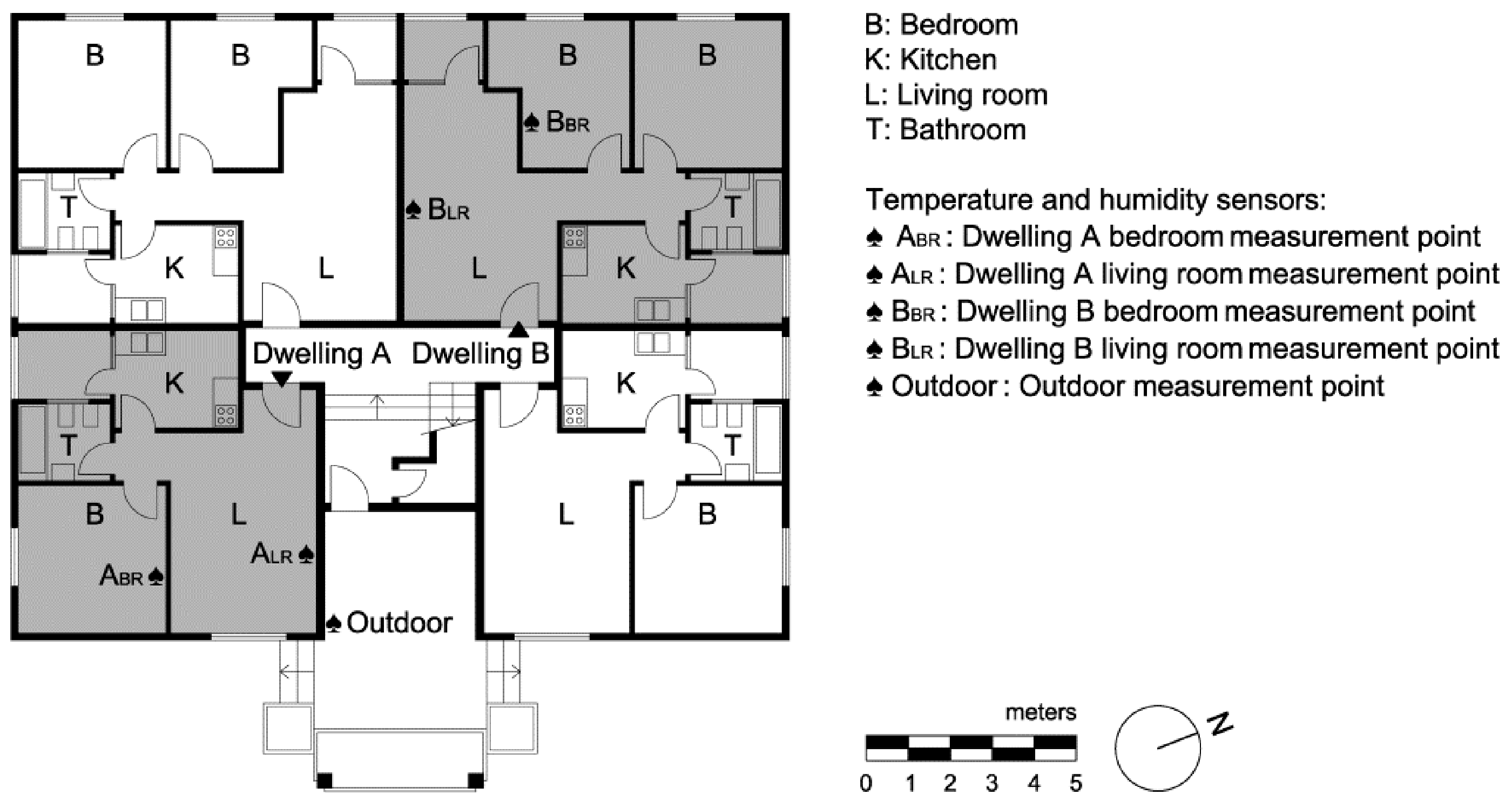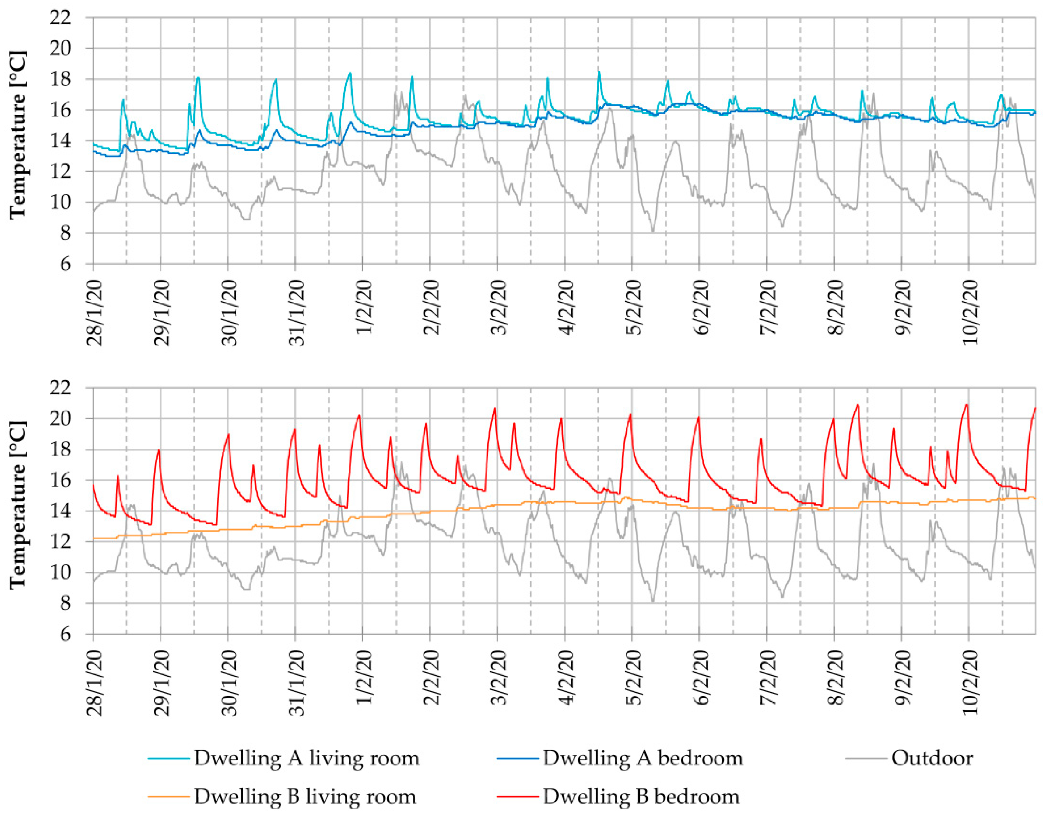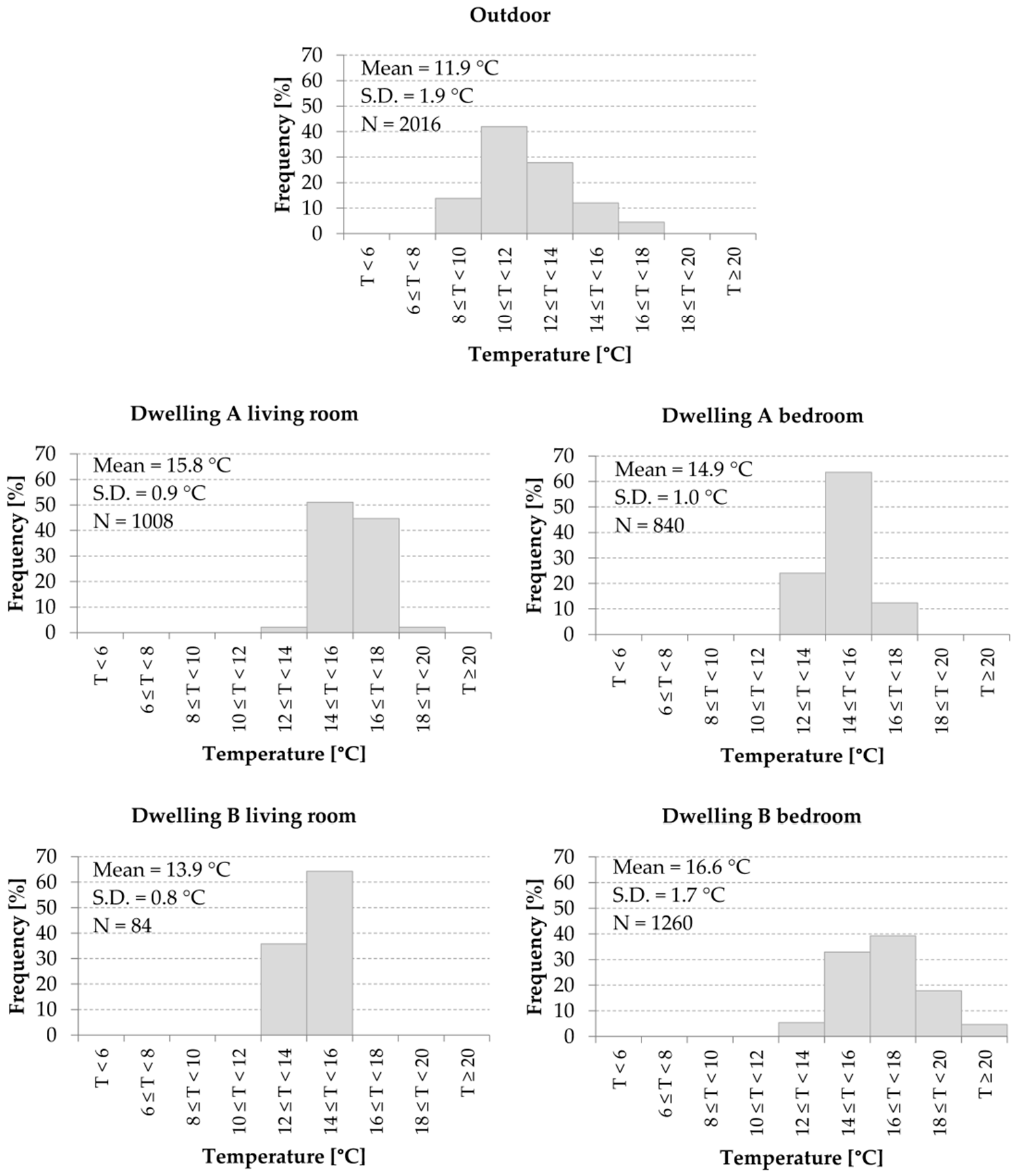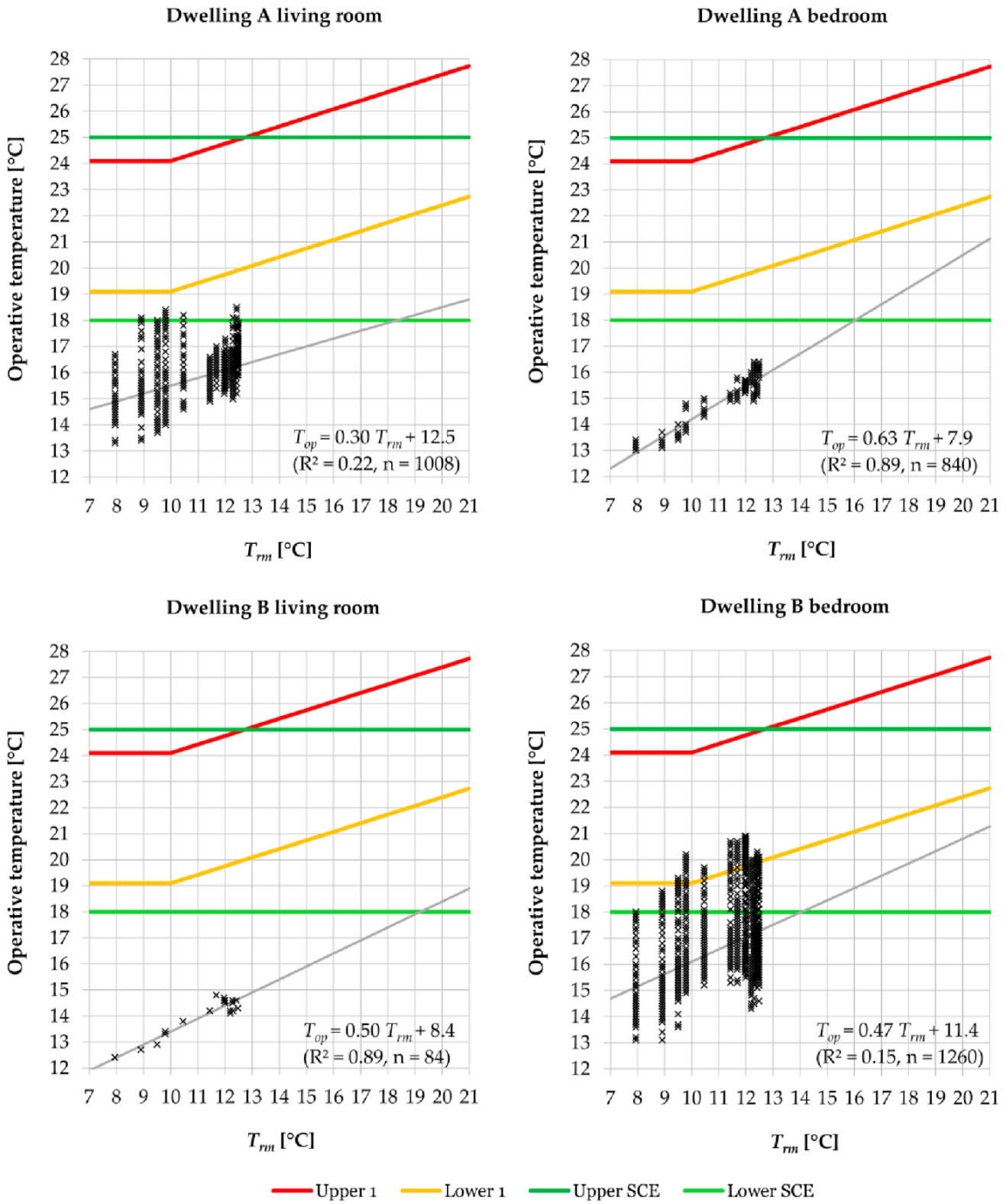Thermal Comfort Assessment during Winter Season: A Case Study on Portuguese Public Social Housing
Abstract
:1. Introduction
1.1. Energy Poverty
1.2. Climate
1.3. Public Social Housing Building Stock
1.4. Indoor Thermal Conditions during Winter Seasons
1.5. Objectives
2. Materials and Methods
2.1. Case Study
2.2. Methodology
2.2.1. Qualitative Data
2.2.2. Quantitative Data
2.2.3. Comfort Assessment
3. Results
3.1. Qualitative Research
3.2. Quantitative Research
3.3. Comfort Assessment
4. Discussion
- The Dwelling A living room allows for an understanding dwelling daytime performance with and without relevant artificial heating influence. In days when active systems are perceived to have been used, its impact consists of a corrective measure that somehow improved indoor thermal conditions, although its use for short periods does not allow for a significantly decrease in discomfort during the relevant occupied time periods. In days when active systems use is reduced or inexistent, alongside with the insignificance of solar gains during morning periods through east-exposed glazed elements, the indoor temperature is generally low, although the impact of high thermal mass is noticeable in its stabilization, considering existent outdoor temperature variability for these periods;
- The Dwelling A bedroom allows for understanding the performance during inhabited night periods under the identified influence of high thermal mass of insulated external panels and indoor partitions, once no active systems are used nor relevant solar gains are identified during the afternoons, considering the room’s southern orientation. Although thermal variability is satisfactorily stable attending outside low temperatures, all registered values are distant from all comfort thresholds;
- The Dwelling B living room allows for understanding the building constructive characteristics’ repercussion in indoor thermal conditions with few or no occupancy impact at all, once no active systems use nor relevant solar gain are perceived. Once again, the influence of high thermal mass is essential for maintaining very stable internal conditions, but with low temperature ranges. With no relevant source of thermal gains, this is clearly the most penalized scenario regarding comfort assessment, where all registered values are considerably distant from all comfort thresholds;
- The Dwelling B bedroom is the room where active systems are used with more consistency according to the intermittent habits during inhabited night and mid-morning periods, considering that no relevant solar gains are obtained during daytime periods. Thus, it allows for an understanding of active systems as brief corrective measures to somehow improve indoor thermal conditions when outside temperatures are lower. Their impact is notorious from the moment they are turned on, with a high temperature increase, so some portion of the inhabited time is within comfort ranges. However, its restricted use until bedtime periods results in a quick drop of indoor temperatures that is unable to be prevented from the moment they are shut down, which demonstrates some insufficiencies in the existing thermal insulation. Nevertheless, it would be interesting to observe the use of active systems during longer and sequent periods to somehow obtain a better understanding of envelope thermal insulation limitations.
5. Conclusions
- Intermittent heating was used during some periods—as by several Portuguese family units—but with a reduced level of effectiveness: thermal discomfort was found to be extremely significant either for static or adaptive models applied, with the monitored rooms—heated or not—presenting 78% to 100% of time in discomfort during inhabited periods, whether during the day or night, as applicable;
- Indoor humidity conditions were inadequate during all occupied periods, outside the recommended humidity ranges. Furthermore, residents’ occupancy habits have little influence on improving these conditions, while many of the recorded values also indicate a high risk of mold growth as a consequence of improper indoor air quality;
- Passive means alone—mainly the existing envelope’s thermal insulation and thermal mass—considered individually or combined with both occupation and intermittent heating habits—were not enough to provide proper indoor thermal conditions;
- It was not possible to properly analyse the impact of solar gains on improving indoor thermal conditions, due to constant use by residents of glazing protections;
- Considering that the present case study focuses on a building with an envelope with superior thermal criteria compared with other identified constructive systems used in local public social housing, the need it to provide constructive improvements for this building stock becomes clear.
Author Contributions
Funding
Informed Consent Statement
Acknowledgments
Conflicts of Interest
References
- Santamouris, M. Innovating to zero the building sector in Europe: Minimising the energy consumption, eradication of the energy poverty and mitigating the local climate change. Sol. Energy 2016, 128, 61–94. [Google Scholar] [CrossRef]
- Li, K.; Lloyd, B.; Liang, X.-J.; Wei, Y.-M. Energy poor or fuel poor: What are the differences? Energy Policy 2014, 68, 476–481. [Google Scholar] [CrossRef]
- Gouveia, J.; Seixas, J.; Palma, P.; Simões, S. LIGAR—Eficiência Energética Para Todos!—Mapeamento da Pobreza Energética em Portugal; Universidade Nova de Lisboa: Lisbon, Portugal, 2018. [Google Scholar]
- Bienvenido-Huertas, D.; Sánchez-García, D.; Rubio-Bellido, C. Adaptive setpoint temperatures to reduce the risk of energy poverty? A local case study in Seville. Energy Build. 2021, 231, 110571. [Google Scholar] [CrossRef]
- Sdei, A. Climate Change Adaptation of Retrofitted Social Housing in the South-East of England. Ph.D. Thesis, University of Brighton, Brighton, UK, 2015. [Google Scholar]
- Office of the Deputy Prime Minister. Housing Health and Safety Rating System. Operating Guidance. Housing Act. 2004. Guidance about Inspections and Assessment of Hazards Given under Section 9; Office of the Deputy Prime Minister: London, UK, 2006. [Google Scholar]
- Magalhães, S.; Freitas, V. A complementary approach for energy efficiency and comfort evaluation of renovated dwellings in Southern Europe. Energy Procedia 2017, 132, 909–914. [Google Scholar] [CrossRef]
- EU Energy Poverty Observatory. Available online: https://www.energypoverty.eu/ (accessed on 10 July 2021).
- Eurostat–Can You Afford to Heat Your Home? Available online: https://ec.europa.eu/eurostat/web/products-eurostat-news/-/DDN-20200106-1?inheritRedirect=true&redirect=%2Feurostat%2F (accessed on 10 July 2021).
- Direção-Geral de Energia e Geologia–PNEC 2030. Available online: https://www.dgeg.gov.pt/pt/areas-transversais/politicas-de-protecao-ao-consumidor-de-energia/pobreza-energetica/o-pnec-e-a-pobreza-energetica/ (accessed on 10 July 2021).
- Attia, S.; Eleftheriou, P.; Xeni, F.; Morlot, R.; Ménézo, C.; Kostopoulos, V.; Betsi, M.; Kalaitzoglou, I.; Pagliano, L.; Cellura, M.; et al. Overview and future challenges of nearly zero energy buildings (nZEB) design in Southern Europe. Energy Build. 2017, 155, 439–458. [Google Scholar] [CrossRef]
- European Environment Agency. Climate Change, Impacts and Vulnerability in Europe 2016 (Report No. 1/2017); Publications Office of the European Union: Luxembourg, 2017. [Google Scholar]
- IPCC. Climate Change 2014: Synthesis Report. Contribution of Working Groups I, II and III to the Fifth Assessment Report of the Intergovernmental Panel on Climate Change; Core Writing Team, Pachauri, R.K., Meyer, L.A., Eds.; IPCC: Geneva, Switzerland, 2014. [Google Scholar]
- Ministério do Ambiente, Ordenamento do Território e Energia—Direção-Geral de Energia e Geologia. Despacho (Extrato) n.° 15793-F/2013; Diário da República n.° 234/2013, 3° Suplemento; Série II de 2013-12-03; Diário da República: Lisbon, Portugal, 2013. [Google Scholar]
- Meteotest–Meteonorm 8 Software. Available online: https://meteonorm.com/en/ (accessed on 10 July 2021).
- Instituto da Habitação e da Reabilitação Urbana. Cem Anos de Políticas Públicas em Portugal. 1918–2018; IHRU: Lisbon, Portugal, 2018. [Google Scholar]
- Curado, A.; Freitas, V.P. Influence of thermal insulation of facades on the performance of retrofitted social housing buildings in Southern European countries. Sustain. Cities Soc. 2019, 48, 101534. [Google Scholar] [CrossRef]
- Barbosa, R.; Vicente, R.; Santos, R. Climate change and thermal comfort in Southern Europe housing: A case study from Lisbon. Build. Environ. 2015, 92, 440–451. [Google Scholar] [CrossRef]
- Figueiredo, A.; Figueira, J.; Vicente, R.; Maio, R. Thermal comfort and energy performance: Sensitivity analysis to apply the Passive House concept to the Portuguese climate. Build. Environ. 2016, 103, 276–288. [Google Scholar] [CrossRef]
- Guedes, M.; Matias, L.; Pina dos Santos, C. Thermal comfort criteria and building design: Field work in Portugal. Renew. Energy 2009, 34, 2357–2361. [Google Scholar] [CrossRef]
- Ortiz, J.; Fonseca, A.; Salom, J.; Garrido, N.; Fonseca, P.; Russo, V. Comfort and economic criteria for selecting passive measures for the energy refurbishment of residential buildings in Catalonia. Energy Build. 2016, 110, 195–210. [Google Scholar] [CrossRef]
- Brito-Coimbra, S.; Aelenei, D.; Gomes, M.G.; Rodrigues, A.M. Building Façade Retrofit with Solar Passive Technologies: A Literature Review. Energies 2021, 14, 1774. [Google Scholar] [CrossRef]
- Curado, A. Thermal Comfort and Energy Efficiency in Retrofitted Social Housing Buildings. Ph.D. Thesis, Faculdade de Engenharia da Universidade do Porto, Porto, Portugal, 2014. [Google Scholar]
- Oteiza, I.; Alonso, C.; Martín-Consuegra, F.; Monjo, J.; González-Moya, M. Energy Retrofitting for Social Housing by Improving the Building Envelope: Madrid, 1939–1979. In The Sustainable Renovation of Buildings and Neighbourhoods; Mercader-Moyano, P., Ed.; Bentham Science Publishers: Sharjah, United Arab Emirates, 2018; pp. 3–32. [Google Scholar]
- Suárez, R.; Fragoso, J. Estrategias pasivas de optimización energética de la vivienda social en clima mediterráneo. Inf. Constr. 2016, 68, e136. [Google Scholar] [CrossRef]
- Casquero-Modrego, N.; Goñi-Modrego, M. Energy retrofit of an existing affordable building envelope in Spain, case study. Sustain. Cities Soc. 2019, 44, 395–405. [Google Scholar] [CrossRef]
- Ramos, N.; Almeida, R.; Simões, M.; Delgado, J.; Pereira, P.; Curado, A.; Soares, S.; Fraga, S. Indoor hygrothermal conditions and quality of life in social housing: A comparison between two neighbourhoods. Sustain. Cities Soc. 2018, 38, 80–90. [Google Scholar] [CrossRef]
- Alonso, C.; Oteiza, I.; Martín-Consuegra, F.; Frutos, B. Methodological proposal for monitoring energy refurbishment. Indoor environmental quality in two case studies of social housing in Madrid, Spain. Energy Build. 2017, 155, 492–502. [Google Scholar] [CrossRef]
- Soares, S.; Brochado, S.; Ramos, N.; Duarte, R.; Norton, P.; Delgado, J.; Fraga, S. Health and living conditions in social housing: Comparison between rehabilitated and non-rehabilitated neighbourhoods. J. Public Health 2016, 24, 535–544. [Google Scholar] [CrossRef]
- Portal do Clima. Available online: http://portaldoclima.pt/pt/ (accessed on 10 July 2021).
- Instituto Nacional de Estatística—Base de Dados. Available online: https://www.ine.pt/xportal/xmain?xpid=INE&xpgid=ine_main (accessed on 10 July 2021).
- Zhao, Q.; Lian, Z.; Lai, D. Thermal comfort models and their developments: A review. Energy Built Environ. 2021, 2, 21–33. [Google Scholar] [CrossRef]
- Rupp, R.; Vásquez, N.; Lamberts, R. A review of human thermal comfort in the built environment. Energy Build. 2015, 105, 178–205. [Google Scholar] [CrossRef]
- Dear, R.; Xiong, J.; Kim, J.; Cao, B. A review of adaptive thermal comfort research since 1998. Energy Build. 2020, 214, 109893. [Google Scholar] [CrossRef]
- Fanger, P. Thermal Comfort. Analysis and Applications in Environmental Engineering; McGraw-Hill: New York, NY, USA, 1970. [Google Scholar]
- Carlucci, S.; Bai, L.; Dear, R.; Yang, L. Review of adaptive thermal comfort models in built environmental regulatory documents. Build. Environ. 2018, 137, 73–89. [Google Scholar] [CrossRef] [Green Version]
- Bienvenido-Huertas, D.; Pulido-Arcas, J.; Rubio-Bellido, C.; Pérez-Fargallo, A. Feasibility of adaptive thermal comfort for energy savings in cooling and heating: A study on Europe and the Mediterranean basin. Urban. Clim. 2021, 36, 100807. [Google Scholar] [CrossRef]
- Comité Européen de Normalisation (CEN). EN 16798-1: Energy Performance of Buildings-Ventilation for Buildings-Part. 1: Indoor Environmental Input Parameters for Design and Assessment of Energy Performance of Buildings Addressing Indoor Air Quality, Thermal Environment, Lighting and Acoustics-Module M1-6; Comité Européen de Normalisation: Brussels, Belgium, 2019. [Google Scholar]
- Nicol, J.; Humphreys, M. Adaptive thermal comfort and sustainable thermal standards for buildings. Energy Build. 2002, 34, 563–572. [Google Scholar] [CrossRef]
- Vellei, M.; Herrera, M.; Fosas, D.; Natarajan, S. The influence of relative humidity on adaptive thermal comfort. Build. Environ. 2017, 124, 171–185. [Google Scholar] [CrossRef]
- Sánchez-García, D.; Bienvenido-Huertas, D.; Tristancho-Carvajal, M.; Rubio-Bellido, C. Adaptive Comfort Control Implemented Model (ACCIM) for Energy Consumption Predictions in Dwellings under Current and Future Climate Conditions: A Case Study Located in Spain. Energies 2019, 12, 1498. [Google Scholar] [CrossRef] [Green Version]
- Ministério da Economia e do Emprego. Decreto-Lei n.° 118/2013; Diário da República n.° 159/2013; Série I de 2013-08-20; Diário da República: Lisbon, Portugal, 2013. [Google Scholar]
- Comité Européen de Normalisation (CEN). EN 16798-2: Energy Performance of Buildings. Ventilation for Buildings–Part. 2. Interpretation of the Requirements in EN 16798-1. Indoor Environmental Input Parameters for Design and Assessment of Energy Performance of Buildings Addressing Indoor Air Quality, Thermal Environment, Lighting and Acoustics (Module M1-6); Comité Européen de Normalisation: Brussels, Belgium, 2019. [Google Scholar]
- American Society of Heating, Refrigerating and Air-Conditioning Engineers (ASHRAE). ANSI/ASHRAE Standard 55-2010 Thermal Environmental Conditions for Human Occupancy; ASHRAE: Atlanta, GA, USA, 2010. [Google Scholar]
- International Organization for Standardization (ISO). ISO 7730:2005. Ergonomics of the Thermal Environment—Analytical Determination and Interpretation of Thermal Comfort Using Calculation of the PMV and PPD Indices and Local Thermal Comfort Criteria; ISO: Geneva, Switzerland, 2005. [Google Scholar]
- International Organization for Standardization (ISO). ISO 7726:1998. Ergonomics of the Thermal Environment—Instruments for Measuring Physical Quantities; ISO: Geneva, Switzerland, 1998. [Google Scholar]
- Matias, L. Development of an Adaptive Model for the Definition of Thermal Comfort Conditions for Portugal. Ph.D. Thesis, Instituto Superior Técnico–Universidade Técnica de Lisboa, Lisbon, Portugal, 2010. [Google Scholar]
- da Piedade, A.C.; Braga, A.; Rodrigues, A. Térmica de Edifícios; Edições Orion: Alfragide, Portugal, 2009. [Google Scholar]
- Shahi, D.; Rijal, H.; Kayo, G.; Shukuya, M. Study on wintry comfort temperature and thermal improvement of houses in cold, temperate, and subtropical regions of Nepal. Build. Environ. 2021, 191, 107569. [Google Scholar] [CrossRef]
- Rijal, H.; Humphreys, M.; Nicol, J. Development of a window opening algorithm based on adaptive thermal comfort to predict occupant behavior in Japanese dwellings. Jpn. Archit. Rev. 2018, 1, 310–321. [Google Scholar] [CrossRef]
- Imagawa, H.; Rijal, H.; Shukuya, M. Development of integrated occupant-behavioural stochastic model including the fan use in Japanese dwellings. Energy Build. 2020, 226, 110326. [Google Scholar] [CrossRef]
- Rajan, K.C.; Rijal, H.; Shukuya, M.; Yoshida, K. An Investigation of the Behavioral Characteristics of Higher- and Lower-Temperature Group Families in a Condominium Equipped with a HEMS System. Buildings 2018, 9, 4. [Google Scholar] [CrossRef] [Green Version]
- Rijal, H. Thermal adaptation of buildings and people for energy saving in extreme cold climate of Nepal. Energy Build. 2021, 230, 110551. [Google Scholar] [CrossRef]
- Rijal, H.; Yoshida, K.; Humphreys, M.; Nicol, J. Development of an adaptive thermal comfort model for energy-saving building design in Japan. Archit. Sci. Rev. 2021, 64, 109–122. [Google Scholar] [CrossRef]
- Yang, L.; Yan, H.; Lam, J. Thermal comfort and building energy consumption implications—A review. Appl. Energy 2014, 115, 164–173. [Google Scholar] [CrossRef]
- Nicol, J.; Humphreys, M.; Roaf, S. Adaptive Thermal Comfort: Principles and Practice; Routledge: London, UK, 2012. [Google Scholar]
- Wang, Z.; Li, A.; Ren, J.; He, Y. Thermal adaptation and thermal environment in university classrooms and offices in Harbin. Energy Build. 2014, 77, 192–196. [Google Scholar] [CrossRef]
- International Organization for Standardization (ISO). ISO 13788:2012. Hygrothermal Performance of Building Components and Building Elements—Internal Surface Temperature to Avoid Critical Surface Humidity and Interstitial Condensation—Calculation Methods; ISO: Geneva, Switzerland, 2012. [Google Scholar]
- Presidência do Conselho de Ministros. Resolução do Conselho de Ministros n.° 48/2015; n.° 136/2015; Série I de 2015-07-15; Diário da República: Lisbon, Portugal, 2015. [Google Scholar]
- Brandão, P.; Lanzinha, J. Precast Concrete Building Construction and Envelope Thermal Behavior: A Case Study on Portuguese Public Social Housing. CivilEng 2021, 2, 271–289. [Google Scholar] [CrossRef]
- Pokharel, T.; Rijal, H.; Shukuya, M. A field investigation on indoor thermal environment and its associated energy use in three climatic regions in Nepal. Energy Build. 2020, 222, 110073. [Google Scholar] [CrossRef]
- Alfano, F.; Olesen, B.; Palella, B.; Pepe, D.; Riccio, G. Fifty Years of PMV Model: Reliability, Implementation and Design of Software for Its Calculation. Atmosphere 2019, 11, 49. [Google Scholar] [CrossRef] [Green Version]
- Humphreys, M.; Nicol, J. The validity of ISO-PMV for predicting comfort votes in every-day thermal environments. Energy Build. 2002, 34, 667–684. [Google Scholar] [CrossRef]







| Period and Month | GR [kWh/m2] | To [°C] | Tmax [°C] | Tmin [°C] | RH [%] | PP [mm] | WS [m/s] |
|---|---|---|---|---|---|---|---|
| 2000–2019 | |||||||
| December | 57 | 7.6 | 10.9 | 4.8 | 78 | 126 | 3.7 |
| January | 64 | 6.7 | 10.1 | 3.9 | 78 | 129 | 3.5 |
| February | 85 | 7.5 | 11.4 | 4.1 | 71 | 87 | 3.8 |
| 2050 (RCP 8.5) | |||||||
| December | 60 | 8.9 | 12.2 | 6.1 | 79 | 116 | 3.7 |
| January | 66 | 8.0 | 11.4 | 5.3 | 79 | 122 | 3.5 |
| February | 89 | 8.6 | 12.4 | 5.4 | 72 | 80 | 3.8 |
| 2080 (RCP 8.5) | |||||||
| December | 61 | 10.1 | 13.4 | 7.4 | 79 | 115 | 3.7 |
| January | 69 | 9.3 | 12.7 | 6.4 | 79 | 114 | 3.5 |
| February | 95 | 9.5 | 13.4 | 6.0 | 72 | 86 | 3.9 |
| Component | Description | Thickness [mm] | U-Value [W/m2 °C] |
|---|---|---|---|
| External walls | Precast concrete panel (30 mm Expanded Polystyrene within) | 150 | 0.99 |
| Internal partitions | Precast concrete panel | 100 | 3.15 |
| Floors and ceilings | Concrete beam/block slab (no thermal insulation) | 180–250 | 1.85–2.32 |
| Glazing and windows | Aluminum frame (no thermal break) Single clear 3 mm glazing Outside uninsulated PVC roller shutters | - | 3.90–6.50 |
| Dwelling A | Dwelling B | |
|---|---|---|
| Occupancy | ||
| Main activities during inhabited periods | Sedentary | Sedentary |
| Inhabited periods schedules | Living room: weekday and weekend from 09:00 a.m. to 21:00 p.m. Bedroom: weekday and weekend from 21:00 p.m. to 07:00 a.m. | Living room: weekday and weekend from 18:00 p.m. to 19:00 p.m. Bedroom: weekday and weekend from 19:00 p.m. to 10:00 a.m. |
| Window protection | External roller shutters: Living room: partially closed during occupied periods (sometimes); totally closed during unoccupied periods Bedroom: totally closed during occupied periods; partially or totally closed during unoccupied periods (sometimes) | External roller shutters Living room: partially closed during occupied periods (sometimes); totally closed during unoccupied periods Bedroom: partially or totally closed during occupied periods; totally closed during unoccupied periods |
| Window opening for air renewal | Living room: brief periods during the morning or afternoon Bedroom: brief periods during the morning | Living room: unusual Bedroom: brief periods during the morning |
| Heating habits using active systems | Living room: portable fan heater, used for brief periods in the mornings and/or afternoons Bedroom: unusual | Living room: unusual Bedroom: portable fan heater, mainly used from early night until bedtime periods during few hours, and occasionally during brief periods in the dawn and/or mornings |
| Strategies to reduce discomfort | Clothing (usual) and hot-water bottles during night periods | Clothing (usual) |
| Internal gains | Typical housing lighting and equipment—low | Typical housing lighting and equipment—low |
| Dwelling evaluation | ||
| Constructive quality (scale 1–5, 5 max.) | 2 | 2 |
| Insulation quality (scale 1–5, 5 max.) | 1 | 1 |
| Considerations regarding the use of active systems for heating | When discomfort is more difficult to tolerate Intermittent use (high energy costs) No specific health problems | When discomfort is more difficult to tolerate Intermittent use (high energy costs) No specific health problems |
| To [°C] | Tmax [°C] | Tmin [°C] | TmaxP [°C] | TminP [°C] | SD [°C] | V [°C] | |
|---|---|---|---|---|---|---|---|
| Outdoor | 11.9 | 15.1 | 9.7 | 17.2 | 8.1 | 1.9 | 5.4 |
| Dwelling A living room | 15.4 | 17.5 | 14.7 | 18.5 | 13.3 | 0.9 | 2.8 |
| Dwelling A bedroom | 14.9 | 15.5 | 14.6 | 16.4 | 13.0 | 0.9 | 0.9 |
| Dwelling B living room | 13.9 | 14.1 | 13.7 | 14.9 | 12.2 | 0.8 | 0.4 |
| Dwelling B bedroom | 16.0 | 20.0 | 14.6 | 20.9 | 13.1 | 1.7 | 5.3 |
| Test | Significance (α) and Critical Value | Honestly Significant Difference (HSD) | Results |
|---|---|---|---|
| ANOVA | α = 0.05 Fcrit = 2.61 | - | F-statistic: F = 1269.82 p-value: p = 0 |
| Tukey HSD | α = 0.05 Qcrit = 3.63 | 0.09 | Mean difference, i—j 1: DA living room/DA bedroom: +0.49 DB living room/DB bedroom: −2.14 DA living room/DB living room: +1.52 DA bedroom/DB bedroom: −1.10 DA living room/DB bedroom: −0.62 DA bedroom/DB living room: +1.03 |
| RH [%] | RHmax [%] | RHmin [%] | SD [%] | |
|---|---|---|---|---|
| Outdoor | 84 | 98 | 47 | 12 |
| Dwelling A living room | 73 | 83 | 62 | 4 |
| Dwelling A bedroom | 76 | 86 | 64 | 5 |
| Dwelling B living room | 77 | 90 | 62 | 5 |
| Dwelling B bedroom | 73 | 85 | 59 | 5 |
| [%] | SCE | EN-C1 |
|---|---|---|
| Dwelling A living room | 98 | 100 |
| Dwelling A bedroom | 100 | 100 |
| Dwelling B living room | 100 | 100 |
| Dwelling B bedroom | 78 | 93 |
Publisher’s Note: MDPI stays neutral with regard to jurisdictional claims in published maps and institutional affiliations. |
© 2021 by the authors. Licensee MDPI, Basel, Switzerland. This article is an open access article distributed under the terms and conditions of the Creative Commons Attribution (CC BY) license (https://creativecommons.org/licenses/by/4.0/).
Share and Cite
Brandão, P.I.; Lanzinha, J.C.G. Thermal Comfort Assessment during Winter Season: A Case Study on Portuguese Public Social Housing. Energies 2021, 14, 6184. https://doi.org/10.3390/en14196184
Brandão PI, Lanzinha JCG. Thermal Comfort Assessment during Winter Season: A Case Study on Portuguese Public Social Housing. Energies. 2021; 14(19):6184. https://doi.org/10.3390/en14196184
Chicago/Turabian StyleBrandão, Pedro I., and João C. G. Lanzinha. 2021. "Thermal Comfort Assessment during Winter Season: A Case Study on Portuguese Public Social Housing" Energies 14, no. 19: 6184. https://doi.org/10.3390/en14196184
APA StyleBrandão, P. I., & Lanzinha, J. C. G. (2021). Thermal Comfort Assessment during Winter Season: A Case Study on Portuguese Public Social Housing. Energies, 14(19), 6184. https://doi.org/10.3390/en14196184







